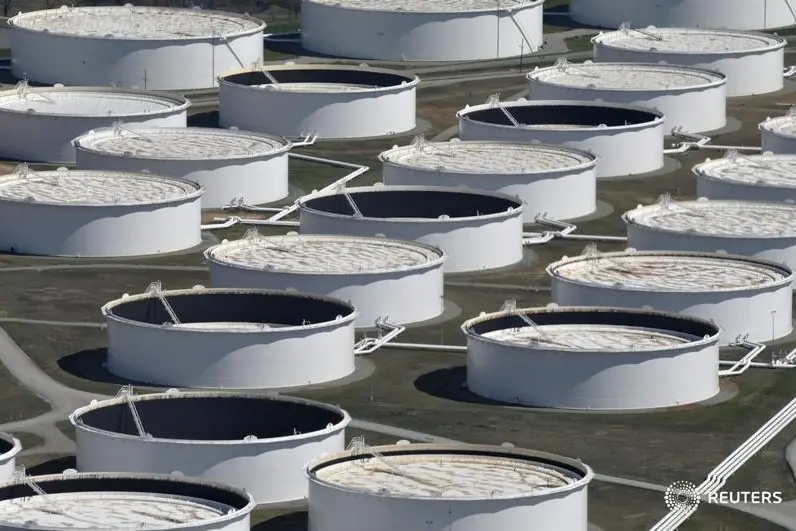PHOTO
LONDON - U.S. crude futures prices have surged higher and the curve has moved into an increasingly severe backwardation as inventories drain away from around the futures delivery point at Cushing in Oklahoma.
There is no doubt the global petroleum market has tightened since the start of the third quarter as a result of Saudi and Russian production cuts as well as an improving economic outlook in the U.S.
But it has probably not tightened anything like as fast or as far as the sudden depletion of inventories at Cushing and the rise in futures prices suggests.
The draw-down of crude inventories in the rest of the U.S. and other major consuming centres in Europe and Asia has been much more modest.
The differential depletion of inventories around the delivery point and abrupt shift into a rampaging backwardation are classic hallmarks of a short squeeze.
The tightening production-consumption balance has created ideal conditions: "You always squeeze the market with the fundamentals, not against them," as one senior trader told me over lunch more than a decade ago.
The severe backwardation is likely to persist until the front-month futures contract approaches expiry on Oct. 20 and/or Cushing inventories start to rise.
CUSHING DRAINED
Front-month U.S. crude futures prices climbed to $94 per barrel on Sept. 27 from $86 on Sept. 1 and $68 on June 27, as traders anticipated inventories will deplete further in the weeks ahead.
The six-month calendar spread tightened into a backwardation of $10 per barrel from $4 on Sept. 1 and a contango of 8 cents on June 27.
The sudden tightening of physical oil supplies at Cushing has coincided with extra production cuts by Saudi Arabia and Russia since the start of July.
The extra cuts will have removed -125 million barrels of crude from the market by the end of September and -245 million barrels by the end of December if implemented in full.
Crude stocks around the futures delivery point depleted by another -1 million barrels over the seven days ending on Sept. 22, according to data from the U.S. Energy Information Administration (EIA).
Cushing inventories had fallen in 12 of the most recent 13 weeks by a total of -21 million barrels since June 23 (“Weekly petroleum status report”, EIA, September 27).
As a result, Cushing stocks were -19 million barrels (-46% or -1.24 standard deviations) below the prior ten-year seasonal average, up from a deficit of just -1 million barrels (-2% or -0.06 standard deviations) at the end of June.
Cushing stocks are at the lowest level for the time of year since 2014 and before that 2008, when futures prices were trading around $121 and $148 per barrel respectively, adjusting for inflation.
Chartbook: U.S. oil inventories and prices
Cushing inventories have depleted much faster and further than in the rest of the country, implying stocks have been drained intentionally.
Commercial crude inventories in the rest of the country have fallen in just eight of the last 13 weeks by a total of only -17 million barrels since June 23.
Cushing inventories accounted for less than 10% of all crude stocks nationwide on June 23 but have since accounted for almost 60% of the nationwide depletion.
Nationwide crude stocks were just -2 million barrels (-0.5% or -0.04 standard deviations) below the ten-year seasonal average on Sept. 22.
The position has changed only slightly from a surplus of +9 million barrels (+2% or +0.15 standard deviations) at the end of June.
DELIVERABLE SUPPLY
Calendar spreads are correlated with the volume of crude readily deliverable against the futures contract, which means oil stored in the tank farms at Cushing or easily deliverable by pipeline, not with total crude stocks.
The intensifying shortage of crude at Cushing has therefore sent calendar spreads flying and in the process lifted front-month prices.
Futures traders with short positions must now pay almost $2.50 per barrel to defer delivery for one month from November 2023 to December 2023, and by more than $6 to defer for three months until February 2024.
The sudden tightening of oil supplies around the delivery point has squeezed hedge funds and other money managers who held bearish short positions.
Hedge fund short positions in the NYMEX futures contract had been cut to just 20 million barrels on Sept. 19 from 136 million barrels on June 27.
Most hedge fund positions are concentrated in futures contracts with nearby dates because they are the most volatile and liquid.
The rush to cover short positions has therefore disproportionately lifted the prices for the front-month futures contract.
Short covering has anticipated, accelerated and amplified the surge in front-month futures prices and the march towards a severe backwardation.
In turn, the rapid strengthening of U.S. crude futures have bled across into other benchmarks including Brent and lifted oil prices worldwide.
John Kemp is a Reuters market analyst. The views expressed are his own (Editing by Jan Harvey)





















